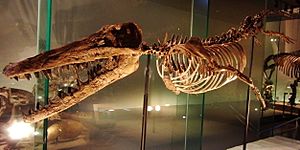Macroevolution facts for kids

Macroevolution is a term for big changes in evolution that happen over very long periods. Think of it as evolution on a grand scale! It's about how new species or even larger groups of living things appear. It also covers the huge changes we see in the fossil record, like how birds evolved from dinosaurs.
Microevolution, on the other hand, is about smaller evolutionary changes. These changes happen within a species or a group of animals or plants. For example, if a population of birds develops slightly different beak sizes over a few generations, that's microevolution. These small changes involve shifts in how common certain genes are in a group. Many scientists believe that if you add up many small microevolutionary changes over a very long time, you get macroevolution.
Contents
How Macroevolution Connects to Microevolution
Scientists study macroevolution using clues from different areas. Paleontology, which is the study of fossils, shows us how life has changed over millions of years. Evolutionary developmental biology looks at how changes in development can lead to big evolutionary shifts. Also, studying the DNA of different creatures helps us see how they are related and how they have changed.
A great example of macroevolution is how feathers appeared during the evolution of birds. Birds evolved from a group of dinosaurs. Over millions of years, small changes added up, leading to the complex feathers we see today.
Most scientists believe that macroevolution is simply the result of many small microevolutionary changes adding up over vast amounts of time. So, the main difference between them is just the time and scale involved.
Some people, like certain creationists, accept microevolution (changes within a species) but not macroevolution (one species evolving into another). However, most biologists disagree. They say there is lots of evidence that macroevolution has happened throughout Earth's history.
Cool Topics in Macroevolution
Scientists who study macroevolution look at many exciting things. Here are a few examples:
- Sudden Bursts vs. Slow Changes: Scientists debate if evolution always happens slowly and steadily (gradualism) or if it sometimes has long periods of little change followed by quick bursts of change (punctuated equilibrium).
- How New Species Form: They study how new species come into being (speciation) and how species disappear (extinction).
- Mass Extinctions: These are times when huge numbers of species die out all at once, like when the dinosaurs disappeared. Scientists study what causes these events and how life recovers afterward.
- Rapid Spreading of Life: Sometimes, a group of animals or plants quickly evolves into many new species. A famous example is the Cambrian Explosion, when many different kinds of animals suddenly appeared in the fossil record.
- Changes in Life's Variety: Researchers track how the total number and types of living things (biodiversity) have changed throughout Earth's history.
- Development's Role in Evolution: They explore how changes in how an animal or plant develops from an embryo can lead to big evolutionary differences.
- Genome Evolution: This looks at how the entire set of DNA (genome) changes over time. This includes things like horizontal gene transfer, where organisms share genes, and changes in the size of a genome.
Where Did the Term Come From?
The terms 'macroevolution' and 'microevolution' were first used in 1927. A Russian scientist named Yuri Filipchenko came up with them.
Since then, what these terms mean has changed a few times. Many scientists today prefer to think of evolution as just one big process, rather than splitting it into "micro" and "macro."
Discussions About Macroevolution
Evolution as a whole is strongly supported by tons of evidence from many different fields of science.
For most biologists, the idea of "macroevolution" is just a convenient way to talk about large-scale changes. They believe these big changes can be explained by the same small-scale processes that cause microevolution. However, a few biologists have suggested that there might be some special evolutionary processes that work only at the level above species. But generally, most scientists think these can still be explained by the usual small changes.
Some people who don't believe in evolution often use the terms "microevolution" and "macroevolution" in a specific way. They might say that any observed change is "just microevolution" and that true "macroevolution" (one species changing into another) can't happen. Biologists, however, point to a lot of evidence that shows macroevolution has indeed occurred in the past.
The discussion among scientists continues. Some believe there's strong evidence for other factors influencing macroevolution, while others maintain that microevolutionary changes fully explain all of macroevolution.
See also
 In Spanish: Macroevolución para niños
In Spanish: Macroevolución para niños

